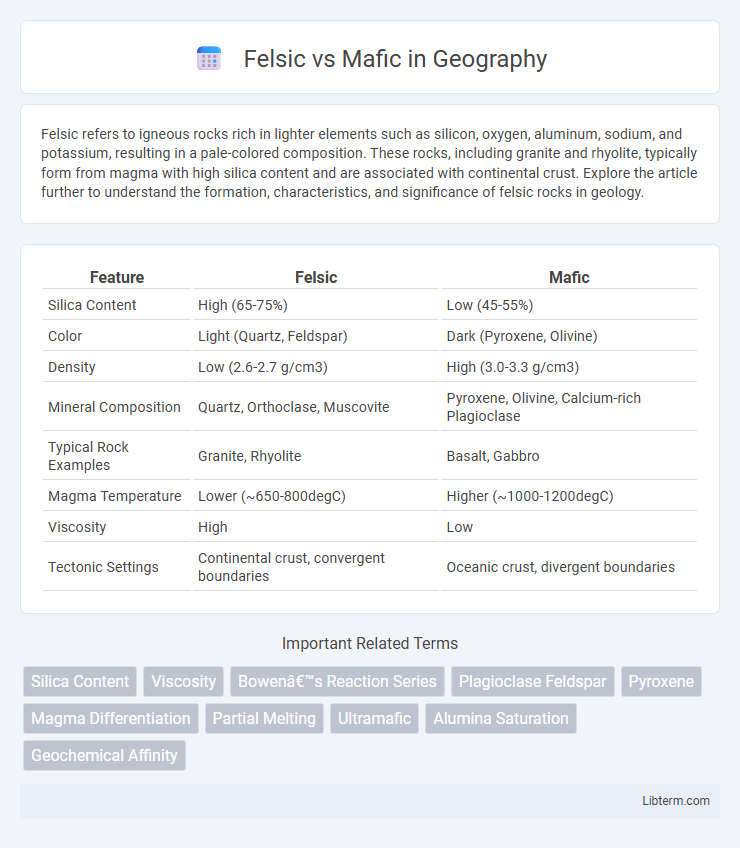Felsic refers to igneous rocks rich in lighter elements such as silicon, oxygen, aluminum, sodium, and potassium, resulting in a pale-colored composition. These rocks, including granite and rhyolite, typically form from magma with high silica content and are associated with continental crust. Explore the article further to understand the formation, characteristics, and significance of felsic rocks in geology.
Table of Comparison
| Feature | Felsic | Mafic |
|---|---|---|
| Silica Content | High (65-75%) | Low (45-55%) |
| Color | Light (Quartz, Feldspar) | Dark (Pyroxene, Olivine) |
| Density | Low (2.6-2.7 g/cm3) | High (3.0-3.3 g/cm3) |
| Mineral Composition | Quartz, Orthoclase, Muscovite | Pyroxene, Olivine, Calcium-rich Plagioclase |
| Typical Rock Examples | Granite, Rhyolite | Basalt, Gabbro |
| Magma Temperature | Lower (~650-800degC) | Higher (~1000-1200degC) |
| Viscosity | High | Low |
| Tectonic Settings | Continental crust, convergent boundaries | Oceanic crust, divergent boundaries |
Introduction to Felsic and Mafic Rocks
Felsic rocks are rich in silica and light-colored minerals like quartz and feldspar, typically forming continental crust. Mafic rocks contain higher amounts of magnesium and iron, with darker minerals such as pyroxene and olivine, and are commonly found in oceanic crust. These compositional differences influence their density, color, and geological behavior, playing a crucial role in Earth's crust formation processes.
Defining Felsic and Mafic: Key Differences
Felsic and mafic are categories of igneous rocks differentiated primarily by their mineral composition and silica content, with felsic rocks containing over 65% silica and rich in lighter minerals like quartz and feldspar, while mafic rocks have 45-52% silica and are abundant in darker minerals such as pyroxene and olivine. Felsic rocks are generally lighter in color and less dense, contrasting with the darker, denser nature of mafic rocks. The differences in mineralogy and chemical composition affect their melting points, viscosity, and tectonic settings, making felsic rocks common in continental crust and mafic rocks prevalent in oceanic crust.
Mineral Composition: Felsic vs Mafic
Felsic rocks are rich in light-colored minerals such as quartz, feldspar, and muscovite, containing high silica content typically over 65%. Mafic rocks contain abundant dark-colored minerals like pyroxene, olivine, and amphibole, with silica content usually between 45% and 55%. The mineral composition differences influence their density, melting points, and overall geochemical properties.
Color and Appearance Comparison
Felsic rocks exhibit light colors such as white, pink, or light gray due to high silica content and abundant minerals like quartz and feldspar, resulting in a coarse-grained or glassy appearance. Mafic rocks display dark colors ranging from black to dark green or brown, caused by higher iron and magnesium content and minerals like pyroxene and olivine, with a dense and fine-grained texture. The contrast in color and appearance between felsic and mafic rocks aids geologists in classifying igneous rock types based on mineral composition and formation conditions.
Formation and Geological Occurrence
Felsic rocks form from magma with high silica content, typically developing in continental crust environments where slower cooling allows large crystals to grow, such as granite in mountain roots. Mafic rocks originate from magma rich in magnesium and iron, commonly found in oceanic crust and volcanic settings like basalt flows at mid-ocean ridges or oceanic hotspots. The contrasting mineral compositions reflect their distinct tectonic and geological settings, influencing rock density, color, and melting points.
Chemical Properties and Silica Content
Felsic rocks are characterized by high silica content, typically above 65%, which results in lighter colors and a composition rich in quartz and feldspar minerals. Mafic rocks contain lower silica levels, generally between 45-55%, and are abundant in iron and magnesium, giving them darker colors due to minerals like pyroxene and olivine. The chemical distinction between felsic and mafic rocks influences their melting points, viscosity, and mineralogy, playing a crucial role in igneous rock classification.
Physical Properties: Density and Texture
Felsic rocks, characterized by high silica content, exhibit lower density, typically ranging from 2.6 to 2.7 g/cm3, and possess a coarse-grained texture due to slower cooling rates. Mafic rocks contain higher iron and magnesium, resulting in greater density between 2.9 to 3.3 g/cm3 and a finer-grained texture attributed to rapid cooling. The contrasting mineral composition directly influences these physical properties, with felsic rocks being lighter and more porous, while mafic rocks are denser and more compact.
Common Examples of Felsic and Mafic Rocks
Granite and rhyolite are common examples of felsic rocks, characterized by high silica content and light-colored minerals such as quartz and feldspar. Basalt and gabbro represent mafic rocks, rich in magnesium and iron, featuring darker minerals like pyroxene and olivine. These distinctions influence their density, color, and typical geological environments, with felsic rocks often forming continental crust and mafic rocks prevalent in oceanic crust.
Uses and Applications in Industry
Felsic rocks, rich in silica and light minerals, are predominantly used in the construction industry for producing durable building materials like granite countertops and decorative stone. Mafic rocks, containing higher amounts of iron and magnesium, are valued in industrial applications such as road base materials, aggregates, and as a source of minerals for steel production. The contrasting mineral compositions directly influence their suitability for specific industrial purposes, with felsic rocks favored for aesthetic applications and mafic rocks preferred for structural and metallurgical uses.
Summary: Choosing Between Felsic and Mafic
Felsic rocks are rich in silica and light-colored minerals such as quartz and feldspar, making them less dense and more viscous compared to mafic rocks. Mafic rocks contain higher amounts of iron and magnesium, resulting in darker colors, greater density, and lower viscosity, which affect their formation and eruption styles. Selecting between felsic and mafic compositions depends on geological context, desired mineral content, and specific volcanic or tectonic processes.
Felsic Infographic

 libterm.com
libterm.com